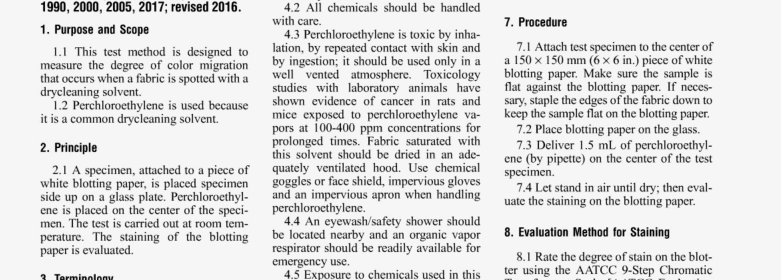olorfastness to Solvent Spotting

AATCC 157-2017 pdf free.olorfastness to Solvent Spotting: Perchloroethylene.
2.1 A specimen. attached to a piece of white blotting paper, is placed spccimen side up on a glass platc. Pcrchloructhylone is placed on the cerner of the specimen. The test is earned out at room ternperature. The staining of thc blotting paper is evaluated.
3. TermlnoIoy
3.1 colorfastness, n.—he resistance of a material to changc in any of its color characteristics. to transfer of its colorant(s) to adjacent materials or both, as a result of the exposure of the material to any environment that might be encountered during the processing, testing, storage or usc of thc material.
3.2 migratIon. n.- the nonuniform movement and distribution of dyes, pigments. finishes or othcr materials from one part of a material to another.
3.3 spottIng. n.—in cleaning, application of solvent or solution to a material prior to or after commercial scouring. laundering, or diyclcaning to remove or enhance removal of soil or stains in a local area.
4. Safety Precautions
NOTE: These safety precautions are for infonnation purposes only. The precautions arc ancillary to the testing procedures and are not intended to be all inclusive, It is the user’s responsibility to usc safe and proper techniques in handling materials in this test method. Manufacwrers MUST be consulted for specific details such as material safety data sheets and other manufacturer’s recommenda tions.
4.2 All chemicals should be handled with care.
4.3 Pcrchloructhylcne is toxic by inhabtion. by repeated contact with skin and by ingestion; it should be used only in a well vented atmosphere. Toxicology studics with laboratory animals have shown evidence of cancer in rats and mice cxposod to pcrchloructhylcnc vapors at 100400 ppm concentrations for prolonged times. Fabric saturated with this solvent should be dried in an adequately ventilated hood. Use chcmical goggles or face shield, impervious gloves and an impervious apron when handling perchloroethylenc.
4.4 An eyewash!safety shower should be located nearby and an organic vapor respirator should be readily available for emergency use.
4.5 Exposure to chemicals used in this procedure must be controlled at or below levels set by governmental authorities (e.g.. Occupational Safety and Health Administration’s [OSHA] pennissible exposure limits [PELI as found in 29 CFR 1910.1000; sec web site:
www.osha.gov for latest version). In addition, the American Conference of(iovcmmental Industrial Hygienists (ACGIH) Threshold Limit Values (TLVs) comprised of time weighted averages (TLVTWA). short term exposure limits (TLV. STEL) and ceiling limits (TLV-C) are recommended as a general guide for air contaminant exposure which should be met (see 10.1).
4.6 The laws regarding perchloroethylone va.y from place to place; therefore. u…er must check local legislation regarding availability and handling requirements.
5. Apparatus, Materials and Reqents
5.1 Pipette. graduated to deliver 1.5 mL.
5.2 Plate, glass.
5.3 AATCC 9-Step Chromatic Transicrerice Scale (AAT(’C Evaluation Procedure 8) (see 10.2).
5.4 White AATCC Textile Blotting Paper (see 10.2).
5.5 Perch loroethylenc: technical or commercial grades arc acceptable.
6.1 Piccc of dyed fabric. 25 x 25 mm (I x I in.).
7. Procedure
7.1 Attach test spec imcn to the ccntcr of a 150 x 150mm (6 x 6 in.) piece of white blotting paper. Make sure the sample is flat against the blotting paper. If ncccssaiy, staple the edges of the fabric down to keep the sample flat on the blotting paper.
7.2 Place blotting paper on the glass.
73 Deliver 1.5 mL of perchlorocihylenc (by pipette) on the center of the test specimen.
7.4 Let stand in air until dry; then evaluate the staining on the blotting papet
8. Evaluation Method t Staining
S. I Rate the degree of stain on the blotter using the AATCC 9-Step Chromatic Transference Scale [AATCC Evaluation Procedure (EP) K] or Instrumental Asscssinent of Degree of Starting (EPI2), and record the numerical rating that corresponds to the appropriate one on it.
9. Precision and Bias
9.1 Precision, Precision for this test method has not been established. Until a precision statement is generated for this method, usc standard statistical techniques in making any comparisons of test results for either within-Iaboraior or berween-laborasor averages.
9.2 Buss. Colorfastness to solvent spotting (pcrchlorocthylene) can be defined only in terms of a test method. There is no independent method for determining the true value. As a means of estimating this property, the method has no known bias.AATCC 157 pdf free download.olorfastness to Solvent Spotting